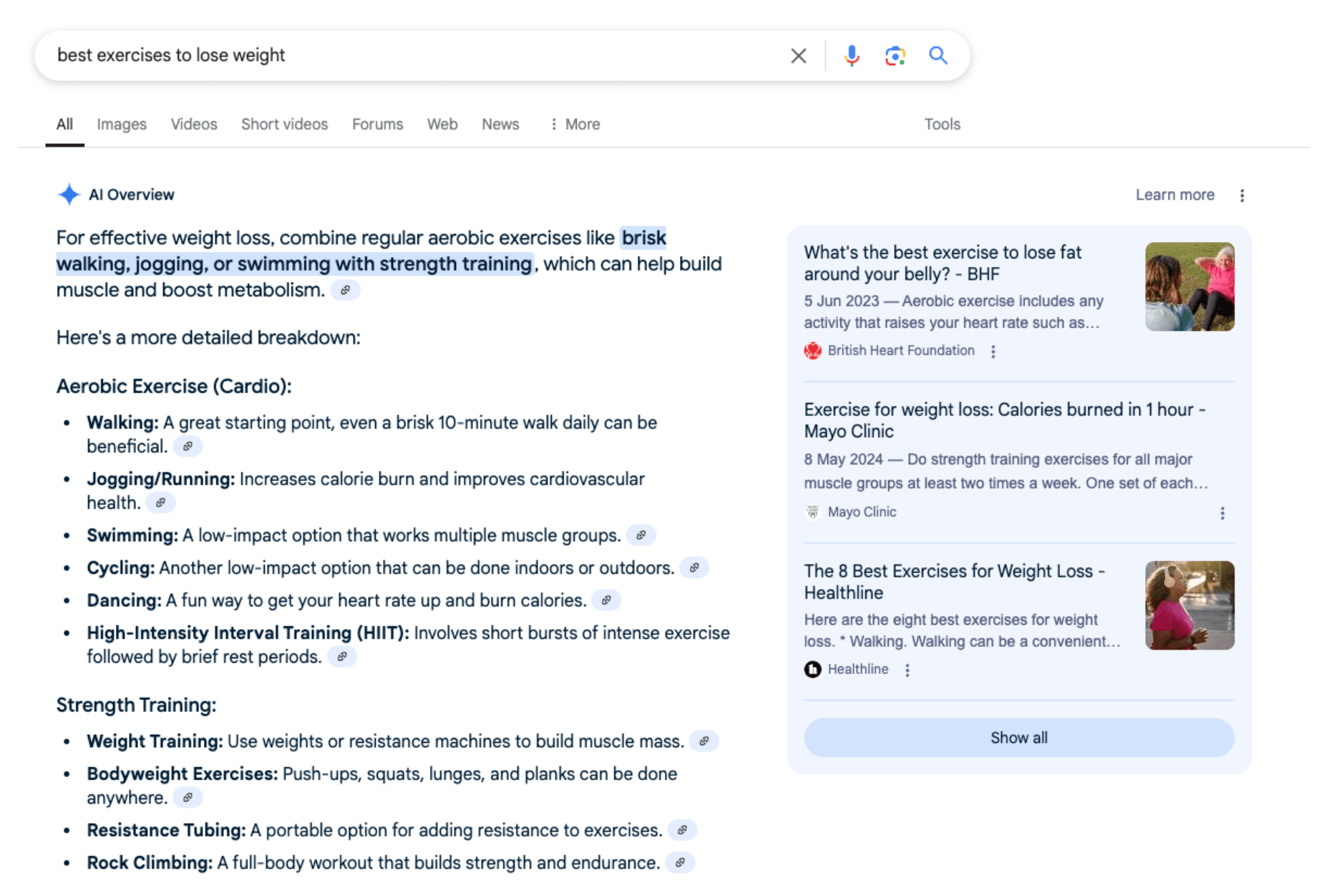Google continues to evolve its search experience, introducing advanced AI-driven features to make information retrieval more intuitive and efficient. Two major developments in this space are AI Overviews and the newly introduced AI Mode. While both leverage artificial intelligence to enhance search, they function differently and have distinct implications for users, content creators, and SEO strategies.
What Are AI Overviews?
AI Overviews are AI-generated summaries that appear at the top of Google Search results, offering users a quick answer to their queries without having to click through multiple links. This feature is an evolution of Google’s existing ‘Featured Snippets’ but with a more sophisticated AI-powered approach.
For example, if you search for “best exercises to lose weight”, AI Overviews might generate a concise, well-structured response listing various workout methods, sourced from multiple web pages. Below the summary, Google may include links to related websites for further reading.

Key Characteristics of AI Overviews
One of the standout features of AI Overviews is their ability to generate concise summaries. These AI-powered responses provide users with quick, easy-to-read answers, eliminating the need to sift through multiple web pages.
Another important characteristic is source aggregation. AI Overviews pull information from multiple reputable websites, collating key points into a single response. This ensures users get a well-rounded answer without having to visit multiple sources.
Finally, AI Overviews often dominate the top of search results, appearing prominently on the SERP. This placement makes it easier for users to find what they need instantly, reducing the necessity of scrolling through traditional organic search results.
What Is Google’s New AI Mode?
AI Mode takes AI-powered search a step further by offering a more interactive, multimodal, and conversational experience. Unlike AI Overviews, which provide a one-time summary, AI Mode allows users to refine their queries and receive dynamic, evolving answers based on follow-up questions.
Additionally, AI Mode integrates Google’s Gemini 2.0 AI model, enabling it to handle text, voice, and image inputs. This means users can upload images, ask spoken questions, and receive context-aware responses tailored to their specific needs.
AI Mode is currently a small-scale opt-in Google Labs experiment which is only available to users based in the US and over the age of 18 however as we have seen with previous experiments this likely means it will hit the UK and other countries in waves in the months to follow.
Key Features of AI Mode
AI Mode introduces a conversational search experience, allowing users to ask follow-up questions and refine their queries in a more interactive way. Instead of receiving a single static response, users can engage in a dynamic exchange, similar to chatting with a virtual assistant. Another major advancement is its multimodal capabilities, which enable searches through text, voice, and even image inputs. This makes AI Mode more flexible and accessible across different user preferences. Additionally, AI Mode delivers more detailed and context-aware responses, offering deeper insights compared to AI Overviews. By understanding complex queries and refining answers based on follow-up interactions, AI Mode creates a more personalised and informative search experience.
For example, if you search “How do I fix a leaking kitchen tap?” in AI Mode, you can upload a picture of your kitchen tap, ask step-by-step questions, and receive tailored troubleshooting advice.
Another example of contextual awareness is that Google AI Mode has the potential to understand your clothing size and preferences to make more personalised recommendations, including trainer/shoe suggestions.
Since AI Mode supports multimodal search, you can type or speak your shoe size and preferences (e.g., “I wear size 10 with wide feet, looking for running shoes”), upload an image of your current trainers to find similar styles as well as ask for recommendations based on past searches or needs (e.g., “Best trainers for flat feet in my size”).
Google’s AI could then refine the results, considering factors like fit, style, and user reviews, and direct you to retailers where you can buy them.
How Do These Changes Impact SEO?
With Google’s shift toward AI-driven search experiences, the SEO landscape is changing rapidly. Here’s what we need to consider:
Reduced Click-Through Rates (CTR)
Since AI Overviews provide immediate answers, users may not feel the need to visit websites, leading to fewer organic clicks. To counteract this, websites should provide unique, in-depth content that AI summaries can’t fully capture. Additionally, sites should optimise for EEAT (Experience, Expertise, Authoritativeness, and Trustworthiness) to be featured in AI-generated results.
Focus on Conversational & Visual Content
With AI Mode supporting follow-up questions, voice search, and image inputs, websites should create FAQ sections and conversational-style content to align with AI Mode’s dynamic responses. Sites should also optimise images and videos for search, as Google increasingly incorporates visual inputs.
New Opportunities for Visibility
Even though AI Overviews may reduce direct clicks, they still feature source links, giving websites brand exposure. To capitalise on this sites should structure content with clear headings, lists, and step-by-step instructions to increase the chances of being cited. It is also not just about the content but who writes them. You should look to provide expert insights, as AI favours high-authority sources.
Is Google Search Becoming More Like an AI Assistant?
With the launch of AI Mode, Google is moving beyond traditional keyword-based search toward a more intelligent, interactive, and multimodal experience. While AI Overviews aim to simplify search results, AI Mode is designed to enhance user engagement with dynamic, conversational interactions.
For businesses, this means adapting strategies to align with Google’s AI-driven future – focusing on rich, authoritative content, optimising for conversational queries, and leveraging multimedia for better search visibility.
As Google’s search landscape evolves with AI-driven features like AI Mode and AI Overviews, staying ahead requires a strategic, data-driven approach to SEO.
At Wilson Cooke, we don’t just keep up with SEO changes – we help you stay ahead of the curve. Our expert team specialises in adapting, optimising, and driving growth in this AI-powered search era. From crafting AI-friendly content and implementing structured data to ensuring technical site stability and refining your strategy for conversational and multimodal search, we help your brand stand out, rank higher, and convert better.


